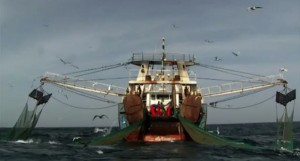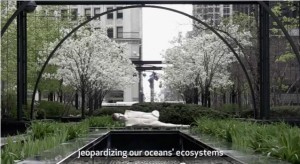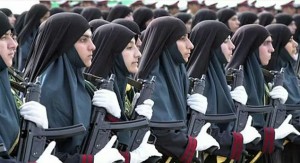Do You Know What They’re Doing?
Today’s society tends to forget that we live in a fragile environment. By messing with the marine life we are messing with our oceans’ ecosystems. This is throwing off the balance, creating more problems for future generations.
For those who do have an awareness, we need to all work together to create change, and for anyone who does not think there are any problems out there, perhaps it is time to consider yourself part of a greater society, and re-examine your conscience – you may be the very one who comes up with the best ideas and solutions.
The AMCS is the voice for Australia’s ocean wildlife and the only national charity dedicated solely to protecting our oceans. We work on the big issues concerning the sea and its threatened wildlife.
Video created for AMCS: Australian Marine Conservation Society
Read MoreShirin Neshat: Art in exile
Shirin Neshat is perhaps the most famous contemporary visual artist to emerge from Iran.
Born in Qavin, one of the most religiouc cities in Iran, her work, predominantly in film and photography draws on her own experiences as an exile from Iran, to explore with great sensitivity Islam and gender relationships and the widening political rift between the West and the Middle East.
——————-
Journalist Peter Bradshaw wrote of Neshat’s debut feature film “Women Without Men” in his 2010 film review in the Guardian:
“The Anglo-Iranian comic Shappi Khorsandi recently revealed that Jon Snow had told her about a conversation he had once had some years ago with the then prime minister, Tony Blair.
The premier had asked Snow, plaintively, why Iran hated the British so much. Snow replied hesitantly: “Well, you know, because of Mossadeq …” – that is, the left-leaning Iranian leader, toppled in 1953 by a coup instigated by the British and American governments because of his determination to nationalise oil.
Blair replied blankly: “Who?”
Perhaps watching this excellent movie would be a way for Blair, and the rest of us, to brush up on British and Iranian history.”
——————-
In this presentation on TED Talks, Shirin Neshat talks about her journey as an artist in exile, with particular reference to her feature film “Women Without Men”.
More information about this on the film’s website
“The story I’d like to share with you today its my challenge as an Iranian artist. as an Iranian woman artist. As an Iranian woman artist living in exile.
Politics Has Defined Our Lives
Well it has its pluses and minuses and the dark side, politics doesn’t seem to escape people like me. Every Iranian artist in one form or another is political. Politics has defined our lives.
If you’re living in Iran you’re facing censorship, harassment, arrest, torture, at times execution. If you’re living outside like me, you’re faced with a life in exile. the pain of the longing and the separation from your loved ones and your family.
Therefore we don’t find the moral and emotional, psychological and political space to distance ourselves from the reality of social responsibility.
Artists as the Voice
Oddly enough, an artist such as myself finds themselves also in the position of being the voice. The speaker of my people, even if I have indeed no access to my own country. Also, people like myself, we’re fighting two battles in different grounds.
We’re being critical of the west, perception of the west about our identity, about the image that is constructed about us, about our women, about our politics, about our religion. We are there to take pride and insist on respect. At the same time we’re fighting another battle that is our regime, our government, our atrocious government who has done every crime in order to stay in power.
Our artists are at risk. We are in a position of danger. We pose a threat to the order of the government, but ironically this situation has empowered all of us because we are considered as artists central to the cultural political social discourse in Iran. We are there to inspire, to provoke, to mobilize, to bring hope for our people.
Culture is a Form of Resistance
We are the reporters of our people and are communicators to the outside world. Art is our weapon. Culture is a form of resistance.
I envy sometimes the artists of the West, for their freedom of expression. For the fact that they can distance themselves from the question of politics. For the fact that they are only serving one audience, namely the Western culture
But also I worry about the West because often in this country, in this western world that we have, culture risks to be a form of entertainment.
Our people depend on our artists and culture is beyond communication.
My journey as an artist started from a very personal place.
I did not start to make social commentaries about my country. The first one that you see in front of you is actually when I first returned to Iran after being separated for a good 12 years. It was after the Islamic revolution of 1979. While I was in absence from Iran, Islamic revolution had descended on Iran and entirely transformed the culture from Persian to Islamic culture.
Women as a Mirror
I came mainly to be reunited with my family and to reconnect in a way that I found my place in society, but instead I found a country that was totally ideological and that I didn’t recognize anymore. More so I became very interested as I was facing my own personal dilemmas and questions I became immersed in the study of the Islamic revolution, how indeed it had incredibly transformed the lives of Iranian women. I found the subject of Iranian women immensely interesting in the way that the women of Iran historically seemed to embody the political transformation. So in a way, by studying a women, you can read the structure and ideology of the country.
So I made a group of work that at once faced my own personal questions in life and yet it brought my work into a larger discourse, the subject of martyrdom, the question of those who willingly stand in that intersection of love of god, faith but violence and crime and cruelty. For me this became incredibly important and yet I had a neutral position towards this.
I was an outsider who had come back to Iran to find my place, but I was not in a position to be critical of the government or the ideology of the Islamic revolution. This changed slowly as I found my voice and I discovered things that I didn’t know I would discover, so my art became slightly more critical, my knife became a little sharper, and I fell into a life in exile.
I am a nomadic artist. I work in Morocco, in Turkey, in Mexico. I go everywhere to make believe it’S Iran. Now I’m making films.
Women Without Men
Last year I finished a film called “Women Without Men”. Women without Men returns to history, but another part of our Iranian history. It goes to 1953 when American CIA exercise a coup and removed democratically elected Dr Mohammad Mosaddegh. The book is written by Iranian woman Shahrnush Parsipur’s , a magic realist novel. This book is banned and she spent 5 years in prison. my Obsession with this book and the reason I made this into a film is because it at once was addressing the question of being a female, traditionally, historically in Iran and the question of four women who are all looking for an ideal, a change, freedom and democracy.
While the country of Iran equally as another character also struggles for an idea of freedom and democracy and independence from the foreign intervention. I made this film because I felt it was important for it to speak to the westerner about our history as a country. All of you seem to remember Iran after the cultural revolution. Iran was once a secular society and we had democracy and this democracy was stolen from us by the American government, by the British government.
The film also talks to the Iranian people in asking them to return to their history and look at themselves before they were so Islamified. In the way we looked, in the way we played music, in the way had intellectual lives, and most of all, in the way that we fought for democracy. These are some of the shots I create for my film. This is some of the images of the coup and we made the film in Cassablanca, recreating all the shots.
This film tries to find a balance between telling a political story but also a feminine story. Being a visual artist indeed I am foremost interested to make art. To make art that transcends politics, religion, the question of feminism and become an important universal work of art.
The challenge I had was how to do that. How to tell a political story but an allegorical story. How to move you with your emotions but also to make your mind work. This is some of the images and the characters of the film.
The Green Movement and Uprising
Now comes the green movement, summer of 2009 as my film is released, uprising begins in Iran. What is unbelievably ironic is the period that we tried to depict in the film, the cry for democracy and social justice repeats itself now, again in Teheran. The green movement significantly inspired the world. It brought a lot of attention to all those Iranians who stand for basic human rights and struggle for democracy. What was most significant again for me was once again, the presence of the women. They are absolutely inspirational for me.
If in the Islamic Revolution the woman portrayed was submissive and didn’t have a voice, now we saw a new idea of feminism in the streets of Teheran. Women who were educated, forward thinking, non traditional, sexually open, fearless and seriously feminist.
These women, and those young men united Iranians across the world, inside and outside.
I then discovered why I take so much inspiration from Iranian women: that under all circumstances they have pushed the boundaries, they confronted the authorities, they have broken every rule, in the smallest and the biggest way and once again they proved themselves.
I stand here today to say that Iranian women have found a new voice and their voice is giving me my voice and it is a great honour to be an Iranian woman and an Iranian artist, even if I have to operate in the west only, for now.”
Read MoreThe End of the Line
 An Ocean Without Fish
An Ocean Without Fish
Imagine an ocean without fish. Imagine your meals without seafood. Imagine the global consequences. This is the future if we do not stop, think and act.
“The End of the Line” was the first major documentary film to reveal the devastating effects of overfishing on our oceans and to show the direct effects of our global love affair with fish as food.
It examines the imminent extinction of bluefin tuna, brought on by the growing western demand for sushi, the impact this has on marine life, such as the huge overpopulation of jellyfish and the profound implications of a future with no fish which would result in mass starvation for many across the globe.
Filmed over a two year period it documented investigative reporter Charles Clover as he confronted politicians and celebrity restaurant owners who expressed little interest in the damage they are doing to the oceans.
One of his allies in his investigations is the whistle-blower Robert Mielgo, a former tuna farmer intent on exposing those involved in destroying the world’s magnificent bluefin tuna population.
The film travels right across the globe, from the Straits of Gibraltar to the coasts of Senegal and Alaska to the Tokyo fish market. It features top scientists, indigenous fishermen and fisheries enforcement officials. The End of the Line is a wake-up call to the world.
The End of Seafood by 2048
Scientists predict that if we continue fishing as we are now, we will see the end of most seafood by 2048
The End of the Line chronicles how high-tech fishing vessels leave no escape routes for fish populations, how farmed fish as a solution is a myth and how the demand for cod off the coast of Newfoundland in the early 1990s led to the decimation of the most abundant cod population in the world.
The responsibility lies with consumers who innocently buy endangered fish, politicians who ignore the advice and pleas of scientists, fishermen who break quotas and fish illegally, and a global fishing industry that is slow to react to an impending disaster.
The End of the Line shows that there are solutions that are simple and doable, but political will and activism are crucial if this is to be solved.
We need to protect large areas of the ocean through a network of marine reserves which are off limits to fishing, to educate consumers that they have a choice by purchasing fish from independently certified sustainable fisheries and to control fishing by reducing the number of fishing boats across the world
Global Campaign
The End of the Line premiered at the Sundance Film Festival in 2009 and was used to launch a global campaign for citizens to demand better marine policies.
Charles Clover, the book’s author said, “We must stop thinking of our oceans as a food factory and realize that they thrive as a huge and complex marine environment.
We must act now to protect the sea from rampant overfishing so that there will be fish in the sea for our grandchildren and great-grandchildren.”
“Overfishing is the great environmental disaster that people haven’t heard about,” said producer George Duffield.
“A recent global conference about bluefin tuna stocks saw almost no media coverage in the U.S. We hope this film really sounds the alarm. We can fix this problem starting right now.”
“Reading the book The End of the Line changed my life and what I eat. I hope the film will do the same for others,” said producer Claire Lewis.
How the film was financed
The End of the Line is a leading example of the new wave of documentary. It is an independent film – made outside the established broadcasting structure.
It is a campaigning film which aims to change the world by engaging large public audiences in a political issue. And it is a project which is integrated with the work of NGOs and progressive companies to achieve this change.
The film’s financing is an example of the new model of funding: with cornerstone funding from the UK’s Channel 4 BRITDOC Foundation, the vast bulk of the finance came from not-for-profit foundations in the UK and the USA.
In the UK the cinema release of the film was supported financially by Waitrose – a major UK retailer.
The film has received financial support from: The Waitt Family Foundation, Marviva, The Oak Foundation, Channel 4 BRITDOC Foundation, WWF, The Weston Foundation, The Clore Foundation, The Marine Conservation Society, AD Charitable Trust, GD Charitable Trust, Waterloo Foundation and Oceana.
Read More(Sign Up and Claim ) Your Piece of the Ocean
Seven tenths of Earth is covered by water and the oceans belong to all of us.
Every individual on Earth has a right to assume that the oceans are managed for the benefit of all those alive, their children and grandchildren – not on behalf of vested interests. If the biological diversity of the oceans is to be maintained or restored, large areas must be protected altogether from the commercial fishing industry and responsible fishing must prevail outside those areas.
Every person on the planet can claim 2 hectares of ocean – that’s what you get if you divide the surface area of ocean by the number of people on Earth.
If the biological diversity of the oceans is to be maintained or restored, large areas must be protected altogether from the commercial fishing industry and responsible fishing must prevail outside those areas.
With some help from our friends at Google, we have created the map you can see here. Anyone willing to pledge their support to the campaign can lay claim to their 2 hectares.
Pledge your support and claim your piece of the ocean here…
Read MoreMarine Conservation (AMCS)
 The AMCS is the voice for Australia’s ocean wildlife and the only national charity dedicated solely to protecting our oceans. We work on the big issues concerning the sea and its threatened wildlife
The AMCS is the voice for Australia’s ocean wildlife and the only national charity dedicated solely to protecting our oceans. We work on the big issues concerning the sea and its threatened wildlife
A lot of us value more than just a coastal view, we love the sea itself. But the sea that we know and love is changing. Once treated as a dumping ground and considered inexhaustible, our oceans are now in crisis and need our help. The Australian Marine Conservation Society is Australia’s only national charity dedicated exclusively to protecting ocean wildlife and their homes.
Australian Marine Conservation Society Website
Our Mission
To protect and celebrate our oceans and their wildlife through community education and action.
Our Beliefs
• Out of respect for nature humans should seek to tread lightly on the Earth.
• As humans our health and well being is intrinsically linked to the health and well being of the Earth.
• As humans we should strive to leave the Earth to our children in a better condition than it was left to us.
• All species from the blue whale to the tiniest crab deserve to live without fear of indiscriminate harm or extinction.
• Our oceans should be celebrated and protected.
• We never doubt that a small group of thoughtful, committed citizens can change the world. Indeed it’s the only thing that ever has (Margaret Mead).
• The community has a right to be involved in decision-making. Good decision-making should be based on informed and considered opinions.
Sanan’s Letter (AK_47)
This video was created in an attempt to raise awareness of children being used as soldiers in SE Asia and Mexico.
All it takes is $7 a month to give one of these kids their childhood back, to rescue and rehabilitate. We hope you find this video uncomfortable. Imagine if it was your child. How uncomfortable would it be then? Visit www.projectak47.com to learn more.
Creative and Production are:
Ronan William Jean David Pierre Quiniou â Announcer
Publicis United & Publicis Modem Russia
Eugene Radewich â Creative Director
Vlad Sergueev â Creative Group Head
Alexey Sergeev â Art Director
Andrey Dodin â Motion Graphics, Graphic Design, Sound Design
Kirill Strelnikov â Copywriter
Richard Williams â Copywriter
Elena Viter â Producer





